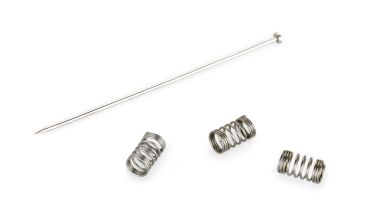
Small Compression Springs: How to Choose the Best One for Your Industry
Small compression springs are mechanical components designed to store and release energy through compression.
Small compression springs are made of coiled wire and operate based on the principle of compression resistance. When an external force compresses them, they store energy in their structure and release it when the pressure decreases.
Their most common form features a helical design and is typically made from materials such as stainless steel, carbon steel, and high-strength alloys, ensuring durability and efficiency.
These springs are essential in many industrial applications because they can handle specific loads and forces. Because they are small, they can be installed in tight spaces without compromising their effectiveness, making them the ideal solution for products that require high precision and reliability.
What Are Small Compression Springs Used For?
In the engineering world, small compression springs serve a variety of functions:
- Impact Absorption: Many devices, especially in industries such as automotive and power tools, use these springs to cushion impacts, improving the lifespan and durability of components.
- Motion Control: In medical and electronic device applications, these springs help control and restrict movement in confined spaces, enabling high-precision operations.
- Energy Storage: Small springs also store energy that can be released to activate or move parts in precision mechanisms, such as watches, microdevices, and valves.
- Maintaining Separation: These springs create a constant minimum space between two components, which can be crucial in medical, electrical, or industrial assembly equipment.
Their versatility makes them widely used in industries that demand reliable and high-quality components, such as automotive, consumer goods, power tools, and medical technology.
Types of Small Compression Springs
Small compression springs vary based on several factors, including material type, design, and intended use. Some of the most common types include:
- Cylindrical Springs: These are the most common compression springs. Their uniform design makes them ideal for standard applications where the spring must provide consistent resistance.
- Conical Springs: These springs are wider at one end and become narrower towards the other, allowing for more excellent stability and compression in tight spaces. They are instrumental in applications where space is limited, and high efficiency is required.
- Variable Pitch Springs: Designed with different distances between coils, these springs provide variable performance under load. They are ideal for applications where the load may change significantly.
- Custom-Shaped Springs: Compression springs can be manufactured with customized shapes or diameters for more specialized applications to meet product requirements better.
Each type of spring is designed to meet the specific needs of different industries and applications, so choosing the right type depends on its function and the working environment where it will be used.
Applications of Compression Springs
Small compression springs are widely used across various industrial sectors. Some of their most notable applications include:
- Automotive: From suspension systems to door mechanisms, springs are essential in many automotive components that require motion control and impact resistance.
- Medical Devices: Medical devices such as autoinjectors, inhalers, and surgical equipment rely on springs to activate mechanisms and maintain precision in their operation.
- Electronics and Appliances: In these industries, compression springs are found in buttons, switches, and other devices that require an immediate and precise response when activated.
- Power Tools: In portable power tools, these springs help minimize the impact on internal components, enhancing the equipment's durability.
- Consumer Goods: From capsule coffee machines to mechanical toys, springs facilitate pushing, bouncing, and adjustment mechanisms, adding value to these products.
Where to Find High-Quality Small Compression Springs?
Selecting a good supplier is crucial to ensuring compliance with quality standards and required specifications for each application. Key factors to consider when choosing a supplier include:
- Manufacturing Experience: Working with experienced manufacturers with in-depth knowledge of small spring production guarantees a high-quality and reliable product.
- Customization: Many industries require springs with unique characteristics. Ensure the supplier can provide customization options in size, material, engineering, and design.
- Technical Support and Consultation: A good supplier provides the product and offers technical support and consultation, helping customers select the right type and design of spring for each application.
- Certified Quality: It is essential that the manufacturer holds quality certifications and conducts thorough inspections of each batch to ensure that the compression springs meet technical and safety requirements.
With over 50 years of experience designing and manufacturing small compression springs, RPK Group understands the specific needs of each sector. We work closely with our customers to provide solutions that truly add value to their products. Our commitment to quality and innovation allows us to offer springs that meet the highest performance and durability standards.